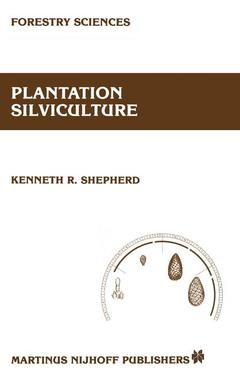Description
Plantation silviculture, Softcover reprint of the original 1st ed. 1986
Coll. Forestry Sciences, Vol. 22
Author: Shepherd K.R.
Language: French
Subjects for Plantation silviculture:
Keywords
Erosion; Grafting; Phosphor; Plantation; Sediment; Sedimentation; Silviculture; Sorption; Sowing; classification; crops; forest; quality; vegetation; wind; Forestry Management
Publication date: 08-2014
322 p. · 15.5x23.5 cm · Paperback
322 p. · 15.5x23.5 cm · Paperback
Description
/li>Contents
/li>
Plantations of a wide range of tree species have assumed an important place in our world, providing wood for industry, fuelwood and animal fodder, protection from adverse environments and for the soil, as well as amenity and aesthetically pleasing landscapes. silvicultural knowledge of this particular branch of forestry first developed in Europe more than two centuries ago but in many parts of the world is still in a process of rapid evolution as more and more plantations are established to meet specific needs. The first exotic tree species to be established in plantations in my own country were planted more than a century ago and, likewise, New Zealand has a long history of planting. Both countries have developed a vigorous and innovative approach to plantation practice, soundly based initially on European experience but gradually modified to meet the challenges of new environments, new markets, and changed economic circumstances. This book on plantation silviculture was begun some years ago when the lack of a suitable undergraduate text for teaching purposes became apparent. The present text is aimed essentially at this audience. Although I have drawn heavily on the experience of Australia and New Zealand, the principles outlined are applicable anywhere in the world where plantations are being grown and tended, from the United States and Scandinavia to India, South Africa or Brazil. The text should also serve as a useful reference to advanced students and practicing foresters, with the reference list providing an introduction to the literature on this subject.
1 Introduction.- Nature of Plantations.- Plantations, Economics and Land Use.- Costs and Benefits.- Silviculture as Both Art and Science.- Silvicultural Systems.- 2 Seed Production.- The Need for Good Quality Seed.- The Reproductive Cycle in Forest Trees.- Factors Influencing Flowering and Seed Production.- Seed Production from the Natural Forest or from Plantation.- Seed Orchards.- 3 Seed Handling.- Trade in Seed.- Seed Collection.- Seed Extraction.- Drying and Storage of Seed.- Seed Testing.- Seed Dormancy and Pre-Sowing Treatment.- 4 Nursery Practice.- Seedlings for Planting.- The Nursery Site.- Bare-Root Seedling Production.- Production of Container Stock.- Asexual or Vegetative Propagation.- Planting Stock Quality.- Nursery Records.- 5 Plantations and Land-Use.- Plantations and Conservation.- Site Evaluation.- Climate.- Site Quality.- Plantation Design.- 6 Growth of Even-Aged Crops.- Tree Stands, and Monocultures.- Growth of Single Stems.- Growth of the Forest Stand.- Stand Growthand Stocking Density.- Biomass Production.- 7 Planting, Site Preparation and Maintenance.- Silvicultural Decisions.- Site Preparation Methods.- Maintaining Site Productivity.- 8 Planting and Early Maintenance.- Choice of Species.- Choice of Espacement.- Planting.- Protection and Early Maintenance.- 9 Pruning.- Reasons for Pruning.- Natural Pruning.- Artificial Pruning.- Pruning and Wood Quality.- 10 Thinning.- Thinning and Growth of Stands.- Objectives of Thinning.- Integration of Forest and Industry.- Biological Considerations.- Thinning Methods.- Thinning, Harvesting and the Environment.- Wind Stability and Thinning.- Thinning and Wood Quality.- 11 Silvicultural Management.- Tactics and Strategies in Silviculture.- A Silvicultural Regime.- Models for Evaluating Silvicultural Alternatives.- Silvicultural Regimes to Suit Different Management Objectives.- Plantations and the Future.- References.
© 2024 LAVOISIER S.A.S.




